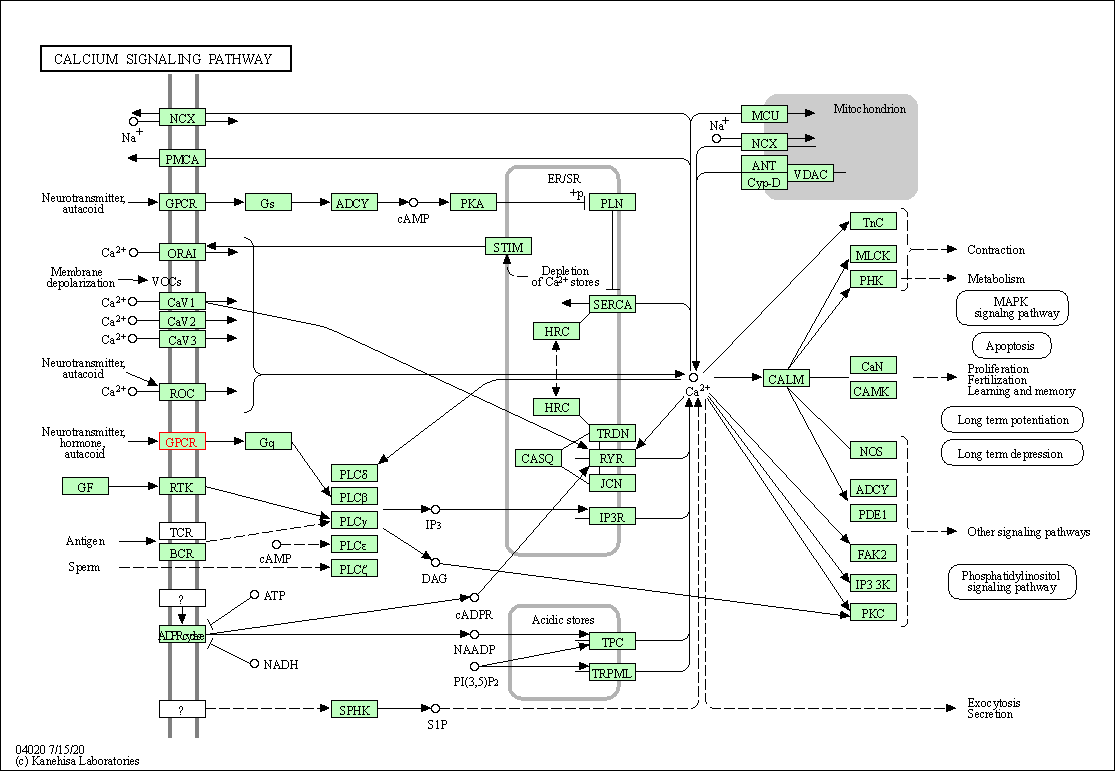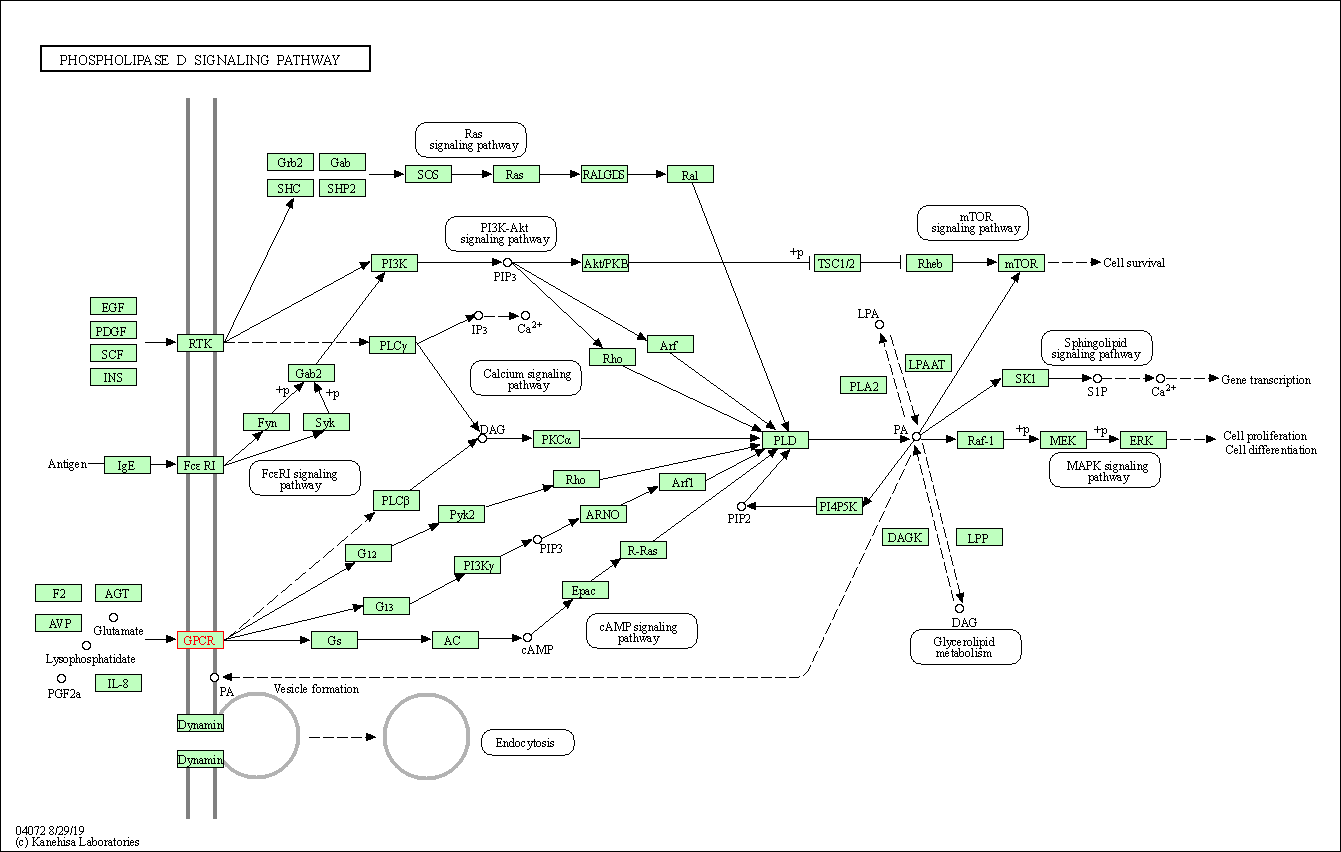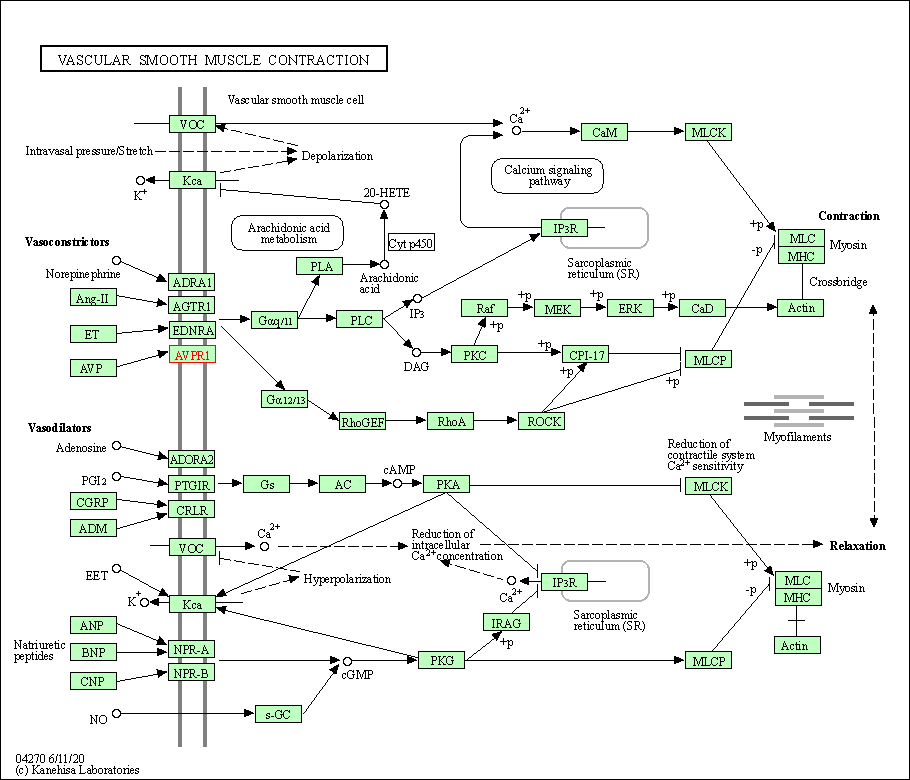Target Information
| Target General Information | Top | |||||
|---|---|---|---|---|---|---|
| Target ID |
T59881
(Former ID: TTDC00298)
|
|||||
| Target Name |
Vasopressin V1b receptor (V1BR)
|
|||||
| Synonyms |
Vasopressin V3 receptor; Vasopressin V(1b) Receptor; VPR3; V1bR; Antidiuretic hormone receptor 1b; AVPR3; AVPR V3; AVPR V1b
Click to Show/Hide
|
|||||
| Gene Name |
AVPR1B
|
|||||
| Target Type |
Successful target
|
[1] | ||||
| Disease | [+] 3 Target-related Diseases | + | ||||
| 1 | Acute diabete complication [ICD-11: 5A2Y] | |||||
| 2 | Autism spectrum disorder [ICD-11: 6A02] | |||||
| 3 | Hypo-osmolality/hyponatraemia [ICD-11: 5C72] | |||||
| Function |
The activity of this receptor is mediated by G proteins which activate a phosphatidyl-inositol-calcium second messenger system. Receptor for arginine vasopressin.
Click to Show/Hide
|
|||||
| BioChemical Class |
GPCR rhodopsin
|
|||||
| UniProt ID | ||||||
| Sequence |
MDSGPLWDANPTPRGTLSAPNATTPWLGRDEELAKVEIGVLATVLVLATGGNLAVLLTLG
QLGRKRSRMHLFVLHLALTDLAVALFQVLPQLLWDITYRFQGPDLLCRAVKYLQVLSMFA STYMLLAMTLDRYLAVCHPLRSLQQPGQSTYLLIAAPWLLAAIFSLPQVFIFSLREVIQG SGVLDCWADFGFPWGPRAYLTWTTLAIFVLPVTMLTACYSLICHEICKNLKVKTQAWRVG GGGWRTWDRPSPSTLAATTRGLPSRVSSINTISRAKIRTVKMTFVIVLAYIACWAPFFSV QMWSVWDKNAPDEDSTNVAFTISMLLGNLNSCCNPWIYMGFNSHLLPRPLRHLACCGGPQ PRMRRRLSDGSLSSRHTTLLTRSSCPATLSLSLSLTLSGRPRPEESPRDLELADGEGTAE TIIF Click to Show/Hide
|
|||||
| 3D Structure | Click to Show 3D Structure of This Target | AlphaFold | ||||
| Drugs and Modes of Action | Top | |||||
|---|---|---|---|---|---|---|
| Approved Drug(s) | [+] 2 Approved Drugs | + | ||||
| 1 | Mozavaptan | Drug Info | Approved | Hyponatraemia | [3], [5], [6] | |
| 2 | Oxytocin | Drug Info | Approved | Autism spectrum disorder | [7] | |
| Clinical Trial Drug(s) | [+] 2 Clinical Trial Drugs | + | ||||
| 1 | ABT-436 | Drug Info | Phase 2 | Anxiety disorder | [8] | |
| 2 | SSR149415 | Drug Info | Phase 2 | Anxiety disorder | [9], [10], [11] | |
| Mode of Action | [+] 4 Modes of Action | + | ||||
| Inhibitor | [+] 25 Inhibitor drugs | + | ||||
| 1 | Mozavaptan | Drug Info | [12] | |||
| 2 | ATOSIBAN | Drug Info | [14] | |||
| 3 | ARGENINE VASOPRESSIN | Drug Info | [17] | |||
| 4 | D[Arg4,Lys8]VP | Drug Info | [17] | |||
| 5 | D[Arg4,Orn8]VP | Drug Info | [17] | |||
| 6 | D[Arg4]AVP | Drug Info | [17] | |||
| 7 | D[Cha4,Dab8]VP | Drug Info | [17] | |||
| 8 | D[Cha4,Dap8]VP | Drug Info | [17] | |||
| 9 | D[Cha4,Lys8]VP | Drug Info | [17] | |||
| 10 | D[Cha4,Orn8]VP | Drug Info | [17] | |||
| 11 | D[Cha4]AVP | Drug Info | [17] | |||
| 12 | D[D-3-Pal2]AVP | Drug Info | [17] | |||
| 13 | D[Leu4,Dab8]VP | Drug Info | [17] | |||
| 14 | D[Leu4,Dap8]VP | Drug Info | [17] | |||
| 15 | D[Leu4,Lys8]VP | Drug Info | [17] | |||
| 16 | D[Leu4]AVP | Drug Info | [17] | |||
| 17 | D[Lys8(5/6-Flu)]VT | Drug Info | [19] | |||
| 18 | D[Orn4,Lys8]VP | Drug Info | [17] | |||
| 19 | D[Orn8(5/6C-Flu)]VT | Drug Info | [19] | |||
| 20 | D[Thr4,Lys8(5/6C-Flu)]VT | Drug Info | [19] | |||
| 21 | D[Thr4,Orn8(5/6C-Flu)]VT | Drug Info | [19] | |||
| 22 | [HO1][Lys8(5/6C-Flu)]VT | Drug Info | [19] | |||
| 23 | [HO1][Orn8(5/6C-Flu)]VT | Drug Info | [19] | |||
| 24 | [HO1][Thr4,Orn8(5/6C-Flu)]VT | Drug Info | [19] | |||
| 25 | [Lys8(Alexa 488) ]PVA | Drug Info | [24] | |||
| Agonist | [+] 2 Agonist drugs | + | ||||
| 1 | Oxytocin | Drug Info | [13] | |||
| 2 | [Val4]AVP | Drug Info | [25] | |||
| Modulator | [+] 1 Modulator drugs | + | ||||
| 1 | ABT-436 | Drug Info | [15] | |||
| Antagonist | [+] 6 Antagonist drugs | + | ||||
| 1 | SSR149415 | Drug Info | [11], [16] | |||
| 2 | d(CH2)5[Tyr(Me)2]AVP | Drug Info | [18] | |||
| 3 | d[Pen1,Tyr(Me)2]AVP | Drug Info | [20] | |||
| 4 | YM 218 | Drug Info | [21] | |||
| 5 | YM 471 | Drug Info | [22] | |||
| 6 | [3H]nelivaptan | Drug Info | [23] | |||
| Cell-based Target Expression Variations | Top | |||||
|---|---|---|---|---|---|---|
| Cell-based Target Expression Variations | ||||||
| Different Human System Profiles of Target | Top |
|---|---|
|
Human Similarity Proteins
of target is determined by comparing the sequence similarity of all human proteins with the target based on BLAST. The similarity proteins for a target are defined as the proteins with E-value < 0.005 and outside the protein families of the target.
A target that has fewer human similarity proteins outside its family is commonly regarded to possess a greater capacity to avoid undesired interactions and thus increase the possibility of finding successful drugs
(Brief Bioinform, 21: 649-662, 2020).
Human Pathway Affiliation
of target is determined by the life-essential pathways provided on KEGG database. The target-affiliated pathways were defined based on the following two criteria (a) the pathways of the studied target should be life-essential for both healthy individuals and patients, and (b) the studied target should occupy an upstream position in the pathways and therefore had the ability to regulate biological function.
Targets involved in a fewer pathways have greater likelihood to be successfully developed, while those associated with more human pathways increase the chance of undesirable interferences with other human processes
(Pharmacol Rev, 58: 259-279, 2006).
Human Similarity Proteins
Human Pathway Affiliation
|
|
| KEGG Pathway | Pathway ID | Affiliated Target | Pathway Map |
|---|---|---|---|
| Calcium signaling pathway | hsa04020 | Affiliated Target |

|
| Class: Environmental Information Processing => Signal transduction | Pathway Hierarchy | ||
| Phospholipase D signaling pathway | hsa04072 | Affiliated Target |

|
| Class: Environmental Information Processing => Signal transduction | Pathway Hierarchy | ||
| Neuroactive ligand-receptor interaction | hsa04080 | Affiliated Target |

|
| Class: Environmental Information Processing => Signaling molecules and interaction | Pathway Hierarchy | ||
| Vascular smooth muscle contraction | hsa04270 | Affiliated Target |

|
| Class: Organismal Systems => Circulatory system | Pathway Hierarchy | ||
| Chemical Structure based Activity Landscape of Target | Top |
|---|---|
| Drug Property Profile of Target | Top | |
|---|---|---|
| (1) Molecular Weight (mw) based Drug Clustering | (2) Octanol/Water Partition Coefficient (xlogp) based Drug Clustering | |
|
|
||
| (3) Hydrogen Bond Donor Count (hbonddonor) based Drug Clustering | (4) Hydrogen Bond Acceptor Count (hbondacc) based Drug Clustering | |
|
|
||
| (5) Rotatable Bond Count (rotbonds) based Drug Clustering | (6) Topological Polar Surface Area (polararea) based Drug Clustering | |
|
|
||
| "RO5" indicates the cutoff set by lipinski's rule of five; "D123AB" colored in GREEN denotes the no violation of any cutoff in lipinski's rule of five; "D123AB" colored in PURPLE refers to the violation of only one cutoff in lipinski's rule of five; "D123AB" colored in BLACK represents the violation of more than one cutoffs in lipinski's rule of five | ||
| Co-Targets | Top | |||||
|---|---|---|---|---|---|---|
| Co-Targets | ||||||
| Target Poor or Non Binders | Top | |||||
|---|---|---|---|---|---|---|
| Target Poor or Non Binders | ||||||
| Target Profiles in Patients | Top | |||||
|---|---|---|---|---|---|---|
| Target Expression Profile (TEP) | ||||||
| Target Affiliated Biological Pathways | Top | |||||
|---|---|---|---|---|---|---|
| KEGG Pathway | [+] 3 KEGG Pathways | + | ||||
| 1 | Calcium signaling pathway | |||||
| 2 | Neuroactive ligand-receptor interaction | |||||
| 3 | Vascular smooth muscle contraction | |||||
| Reactome | [+] 2 Reactome Pathways | + | ||||
| 1 | Vasopressin-like receptors | |||||
| 2 | G alpha (q) signalling events | |||||
| WikiPathways | [+] 5 WikiPathways | + | ||||
| 1 | GPCRs, Class A Rhodopsin-like | |||||
| 2 | Gastrin-CREB signalling pathway via PKC and MAPK | |||||
| 3 | Peptide GPCRs | |||||
| 4 | GPCR ligand binding | |||||
| 5 | GPCR downstream signaling | |||||
| Target-Related Models and Studies | Top | |||||
|---|---|---|---|---|---|---|
| Target Validation | ||||||
| References | Top | |||||
|---|---|---|---|---|---|---|
| REF 1 | Design of potent and selective agonists for the human vasopressin V1b receptor based on modifications of [deamino-cys1]arginine vasopressin at position 4. J Med Chem. 2004 Apr 22;47(9):2375-88. | |||||
| REF 2 | URL: http://www.guidetopharmacology.org Nucleic Acids Res. 2015 Oct 12. pii: gkv1037. The IUPHAR/BPS Guide to PHARMACOLOGY in 2016: towards curated quantitative interactions between 1300 protein targets and 6000 ligands. (Ligand id: 2182). | |||||
| REF 3 | Drugs@FDA. U.S. Food and Drug Administration. U.S. Department of Health & Human Services. 2015 | |||||
| REF 4 | ClinicalTrials.gov (NCT00748072) 1-deamino 8-d-arginine Vasopressin (DDAVP) in Percutaneous Ultrasound-guided Renal Biopsy. U.S. National Institutes of Health. | |||||
| REF 5 | Trusted, scientifically sound profiles of drug programs, clinical trials, safety reports, and company deals, written by scientists. Springer. 2015. Adis Insight (drug id 800001739) | |||||
| REF 6 | URL: http://www.guidetopharmacology.org Nucleic Acids Res. 2015 Oct 12. pii: gkv1037. The IUPHAR/BPS Guide to PHARMACOLOGY in 2016: towards curated quantitative interactions between 1300 protein targets and 6000 ligands. (Ligand id: 2197). | |||||
| REF 7 | URL: http://www.guidetopharmacology.org Nucleic Acids Res. 2015 Oct 12. pii: gkv1037. The IUPHAR/BPS Guide to PHARMACOLOGY in 2016: towards curated quantitative interactions between 1300 protein targets and 6000 ligands. (Ligand id: 2174). | |||||
| REF 8 | ClinicalTrials.gov (NCT01741142) Efficacy and Safety Study of ABT-436 in Major Depressive Disorder. U.S. National Institutes of Health. | |||||
| REF 9 | URL: http://www.guidetopharmacology.org Nucleic Acids Res. 2015 Oct 12. pii: gkv1037. The IUPHAR/BPS Guide to PHARMACOLOGY in 2016: towards curated quantitative interactions between 1300 protein targets and 6000 ligands. (Ligand id: 2202). | |||||
| REF 10 | Anxiolytic- and antidepressant-like effects of the non-peptide vasopressin V1b receptor antagonist, SSR149415, suggest an innovative approach for t... Proc Natl Acad Sci U S A. 2002 Apr 30;99(9):6370-5. | |||||
| REF 11 | Novel drugs and therapeutic targets for severe mood disorders. Neuropsychopharmacology. 2008 Aug;33(9):2080-92. | |||||
| REF 12 | New analgesic drugs derived from phencyclidine. J Med Chem. 1981 May;24(5):496-9. | |||||
| REF 13 | The human V3 pituitary vasopressin receptor: ligand binding profile and density-dependent signaling pathways. Endocrinology. 1997 Oct;138(10):4109-22. | |||||
| REF 14 | The discovery of GSK221149A: a potent and selective oxytocin antagonist. Bioorg Med Chem Lett. 2008 Jan 1;18(1):90-4. | |||||
| REF 15 | The vasopressin Avprlb receptor: Molecular and pharmacological studies. Stress. 2011 January; 14(1): 98-115. | |||||
| REF 16 | Tetrahydroquinoline sulfonamides as vasopressin 1b receptor antagonists. Bioorg Med Chem Lett. 2009 Nov 1;19(21):6018-22. | |||||
| REF 17 | Design and synthesis of the first selective agonists for the rat vasopressin V(1b) receptor: based on modifications of deamino-[Cys1]arginine vasop... J Med Chem. 2007 Feb 22;50(4):835-47. | |||||
| REF 18 | 1-desamino-8-D-arginine vasopressin (DDAVP) as an agonist on V1b vasopressin receptor. Biochem Pharmacol. 1997 Jun 1;53(11):1711-7. | |||||
| REF 19 | Synthesis and characterization of fluorescent antagonists and agonists for human oxytocin and vasopressin V(1)(a) receptors. J Med Chem. 2002 Jun 6;45(12):2579-88. | |||||
| REF 20 | Pharmacological characterization of the human vasopressin receptor subtypes stably expressed in Chinese hamster ovary cells. Br J Pharmacol. 1998 Dec;125(7):1463-70. | |||||
| REF 21 | Effects of YM218, a nonpeptide vasopressin V1A receptor-selective antagonist, on human vasopressin and oxytocin receptors. Pharmacol Res. 2005 Mar;51(3):275-81. | |||||
| REF 22 | Effects of YM471, a nonpeptide AVP V(1A) and V(2) receptor antagonist, on human AVP receptor subtypes expressed in CHO cells and oxytocin receptors in human uterine smooth muscle cells. Br J Pharmacol. 2001 Jul;133(5):746-54. | |||||
| REF 23 | URL: http://www.guidetopharmacology.org Nucleic Acids Res. 2015 Oct 12. pii: gkv1037. The IUPHAR/BPS Guide to PHARMACOLOGY in 2016: towards curated quantitative interactions between 1300 protein targets and 6000 ligands. (Target id: 367). | |||||
| REF 24 | Toward efficient drug screening by homogeneous assays based on the development of new fluorescent vasopressin and oxytocin receptor ligands. J Med Chem. 2007 Oct 4;50(20):4976-85. | |||||
| REF 25 | [1-deamino-4-cyclohexylalanine] arginine vasopressin: a potent and specific agonist for vasopressin V1b receptors. Endocrinology. 2002 Dec;143(12):4655-64. | |||||
If You Find Any Error in Data or Bug in Web Service, Please Kindly Report It to Dr. Zhou and Dr. Zhang.

